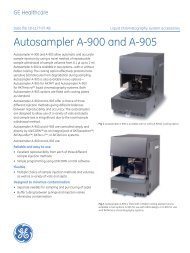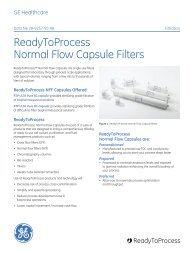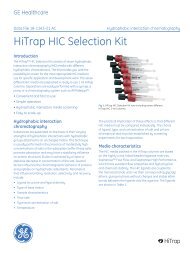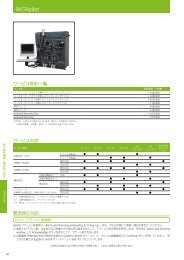TiO2 Mag Sepharose™
TiO2 Mag Sepharose™
TiO2 Mag Sepharose™
Create successful ePaper yourself
Turn your PDF publications into a flip-book with our unique Google optimized e-Paper software.
GE Healthcare<br />
Data file 28-9539-44 AA<br />
Protein sample preparation<br />
TiO 2 <strong>Mag</strong> Sepharose <br />
TiO 2 <strong>Mag</strong> Sepharose magnetic beads use titanium dioxide<br />
(TiO 2 )-based chromatography to simplify capture and<br />
enrichment of phosphopeptides (Fig 1). TiO 2 has high affinity<br />
for phosphopeptides and provides efficient enrichment of<br />
phosphopeptides from complex samples.<br />
TiO 2 <strong>Mag</strong> Sepharose benefits are:<br />
• Selective enrichment of phosphopeptides<br />
• Easy to use — visible and dense magnetic beads<br />
• Simple protocol with elution conditions optimized for MS<br />
analysis<br />
• Parallel handling of samples — six samples can be<br />
processed in less than one hour<br />
Phosphorylation is a common reversible posttranslational<br />
modification involved in the regulation of<br />
many essential biological processes. Phosphoproteins<br />
and phosphopeptides are usually present at very low<br />
concentrations and ionize poorly, making their detection by<br />
mass spectrometry (MS) difficult.<br />
Phosphopeptides from, for example, trypsin-digested<br />
protein sample bind to TiO 2 while non-phosphopeptides<br />
and other components remain in the sample solution.<br />
Sample preparation procedures resulting in enrichment<br />
of phosphopeptides simplifies identification of<br />
phosphoproteins by MS. With improved sensitivity, this<br />
method allows identification of phosphoproteins down to<br />
femtomol levels.<br />
TiO 2 <strong>Mag</strong> Sepharose is available in two pack sizes: 1 × 500 µl<br />
suitable for 10 samples and 4 × 500 µl suitable for 40<br />
samples. Together with <strong>Mag</strong>Rack 6, a separation tool for<br />
handling the beads in microcentrifuge tubes, up to six<br />
samples can be processed in parallel. The rack consists of<br />
anodized aluminum housing with a detachable plastic bar<br />
containing six neodymium magnets.<br />
TiO 2 <strong>Mag</strong> Sepharose is a complementary product to<br />
Phos SpinTrap Fe, a non-magnetic IMAC-based<br />
chromatography medium.<br />
Fig 1. TiO 2 <strong>Mag</strong> Sepharose is designed for efficient small-scale enrichment<br />
of phosphopeptides.<br />
Simple handling<br />
TiO 2 <strong>Mag</strong> Sepharose improves ease-of-use in sample<br />
preparation of phosphopeptides. The magnetic bead format<br />
has excellent properties for small-scale experiments.<br />
The high density of the beads allows rapid capture by<br />
magnetic devices while the visibility of the beads ensures<br />
reliable collection of all target peptides bound (Fig 2). The<br />
characteristics of TiO 2 <strong>Mag</strong> Sepharose are summarized in<br />
Table 1. The products are provided with protocols optimized<br />
for downstream analysis, such as MALDI-ToF MS and LC-MS.<br />
<strong>Mag</strong>Rack 6 enables preparation of up to six samples<br />
captured in 1.5 ml microcentrifuge tubes. When the tubes<br />
are placed in the rack, the magnetic beads are attracted to<br />
the magnet within a few seconds. This allows easy removal<br />
of the supernatant whereas the magnetic beads are left in<br />
the tube.<br />
imagination at work<br />
SepharoseTM
Fig 2. The high density of the beads allows rapid capture by <strong>Mag</strong>Rack 6<br />
magnetic device.<br />
Table 1. Characteristics of TiO 2 <strong>Mag</strong> Sepharose<br />
Matrix<br />
Paramagnetic, spherical, highly crosslinked<br />
agarose particles<br />
Ligand TiO 2<br />
Particle size 37–100 µm<br />
Working temperature Room temperature<br />
Storage solution<br />
20% ethanol<br />
Storage temperature 4°C to 30°C<br />
Reproducible peptide enrichment:<br />
a benchmark analysis<br />
To demonstrate efficiency and sensitivity, TiO 2 <strong>Mag</strong><br />
Sepharose was compared with two other products. The<br />
comparison was performed in GE Healthcare’s laboratories.<br />
Parallel experiments were set up with Phos-trap<br />
Phosphopeptide Enrichment Kit (PerkinElmer Inc), and<br />
Titansphere Phos-TiO Kit (GL Sciences Inc). Titansphere<br />
Phos-TiO Kit is tip-based while TiO 2 <strong>Mag</strong> Sepharose<br />
and Phos-trap Phosphopeptide Enrichment Kit add the<br />
advantages with magnetic beads.<br />
Two phosphorylated proteins (α-casein and β-casein) and<br />
one non-phosphorylated protein (bovine serum albumin)<br />
were reduced and alkylated with Tris(2-carboxyethyl)<br />
phosphine (TCEP) and iodoacetamide, respectively, followed<br />
by trypsin-digestion. A total of 50 pmol of each protein<br />
digest was mixed, applied to each separation medium,<br />
and used according to the procedures recommended<br />
by the manufacturer as summarized in Table 2. After<br />
enrichment, eluates were lyophilized and dissolved in<br />
20% acetonitrile with 0.1% trifluoroacetic acid (TFA,<br />
20 μl) and analyzed by MALDI-ToF MS. All three products<br />
enriched phosphopeptides. MS spectra with annotated<br />
phosphopeptides are shown in Figure 3A.<br />
Titansphere Phos-TiO Kit detected six peptides, whereas<br />
TiO 2 <strong>Mag</strong> Sepharose found five peptides, and Phos-trap<br />
Phosphopeptide Enrichment Kit detected three peptides.<br />
Furthermore, different ratios between phosphopeptides and<br />
non-phosphorylated peptides were obtained.<br />
The ratio obtained for TiO 2 <strong>Mag</strong> Sepharose was 2.5. The<br />
equivalent ratios for Phos-trap Phosphopeptide Enrichment<br />
Kit and Titansphere Phos-TiO Kit were 0.5 and 0.6,<br />
respectively. These results demonstrate the high selectivity<br />
for phosphopeptides using TiO 2 <strong>Mag</strong> Sepharose.<br />
When the three eluates were diluted 100-fold, the<br />
MS spectra showed different patterns (Fig 3B). Two<br />
phosphopeptides could still be detected in the eluate from<br />
TiO 2 <strong>Mag</strong> Sepharose, while the other two eluates displayed<br />
one phosphopeptide.<br />
Table 2. Experimental conditions<br />
TiO 2 <strong>Mag</strong> Sepharose<br />
PhosTrap Phosphopeptide Titansphere Phos-TiO Kit<br />
Enrichment Kit<br />
Format <strong>Mag</strong>netic medium <strong>Mag</strong>netic medium Prepacked tip column<br />
Sample<br />
Mix of tryptic fragments from<br />
bovine serum albumin, α-casein<br />
and β-casein (50 pmol each)<br />
Mix of tryptic fragments from<br />
bovine serum albumin, α-casein<br />
and β-casein (50 pmol each)<br />
Mix of tryptic fragments from<br />
bovine serum albumin, α-casein<br />
and β-casein (50 pmol each)<br />
Sample volume 100 µl 100 µl 130 µl<br />
Conditioning/equilibration<br />
1 × 500 µl binding buffer<br />
(1 M glycolic acid, 5% TFA,<br />
80% acetonitrile)<br />
3 × 200 µl binding buffer from kit 1 × 20 µl solution A from kit<br />
1 × 20 µl solution B from kit<br />
Binding 1 × 30 min 1 × 1 min 2 × 10 min<br />
Washing<br />
1 × 500 µl binding buffer<br />
2 × 500 µl washing buffer<br />
(1% TFA, 80% acetonitrile)<br />
4 × 200 µl binding buffer from kit<br />
1 × 200 µl washing buffer from kit<br />
1 × 20 µl solution B from kit<br />
1 × 20 µl solution A from kit<br />
(cycle repeated twice)<br />
Elution<br />
2 × 50 µl elution buffer<br />
(5% ammonia)<br />
1 × 10 µl elution buffer from kit 1 × 50 µl of 0.5% ammonia<br />
(recycle once)<br />
2 28-9539-44 AA
A<br />
B<br />
Intens. [a.u.]<br />
Intens. [a.u.]<br />
Intens. [a.u.]<br />
Intens. [a.u.]<br />
×10 4<br />
1.00<br />
0.50<br />
0<br />
6000<br />
4000<br />
2000<br />
0<br />
×10 4<br />
4<br />
3<br />
2<br />
1<br />
0<br />
3000<br />
2000<br />
1000<br />
1014.714<br />
I<br />
II<br />
III<br />
1011.293<br />
1052.316<br />
1138.657<br />
1163.778<br />
1249.769<br />
1324.896<br />
1337.763<br />
1362.483<br />
1383.977<br />
1418.366<br />
1479.990<br />
1538.000<br />
1567.938<br />
1579.721<br />
1640.142<br />
1660.389<br />
1660.522<br />
1717.529<br />
1749.885<br />
1817.182<br />
* *<br />
*<br />
1798.345<br />
1889.125<br />
1870.350<br />
1870.557<br />
* *<br />
1823.637<br />
1927.511<br />
*<br />
1951.488<br />
1940.530<br />
1980.299<br />
2008.500<br />
2045.229<br />
*<br />
2061.319<br />
•<br />
*<br />
2061.550<br />
•<br />
*<br />
IV *<br />
* *<br />
2061.519<br />
2202.364<br />
2815.846<br />
2880.220<br />
2959.277<br />
2959.564<br />
2959.593<br />
*<br />
*<br />
3039.496<br />
3039.768<br />
3039.747<br />
3121.648<br />
3121.914<br />
3121.841<br />
3175.616<br />
Intens. [a.u.]<br />
Intens. [a.u.]<br />
Intens. [a.u.]<br />
Intens. [a.u.]<br />
×10 4<br />
1.25<br />
1.00<br />
0.75<br />
0.50<br />
0.25<br />
0.00<br />
6000<br />
4000<br />
2000<br />
0<br />
1014.714<br />
*3122.510<br />
1500<br />
1250<br />
1000<br />
750<br />
500<br />
250<br />
0<br />
1500<br />
1000<br />
500<br />
I<br />
II<br />
III<br />
IV<br />
1138.657<br />
1163.778<br />
1249.769<br />
1324.896<br />
1383.977<br />
1479.990<br />
1538.000<br />
1567.938<br />
1640.142<br />
1749.885<br />
1817.182<br />
1889.125<br />
1980.776<br />
2045.229<br />
2202.364<br />
*<br />
2061.914<br />
•<br />
*<br />
2061.857<br />
*<br />
3122.308<br />
0<br />
1250 1500 1750 2000 2250 2500 2750 3000 m/z<br />
0<br />
1000 1250 1500 1750 2000 2250 2500 2750 3000 m/z<br />
* = phosphopeptide • = metastable phosphopeptide<br />
Fig 3. MALDI-ToF MS analysis of trypsin-digested protein mix (50 pmol each of BSA, α-casein, and β-casein) enriched using three different chromatographic<br />
media. (A) Spotting from lyophilized eluates dissolved in 20 µl and (B) eluates diluted 100-fold before spotting. The spectra show start material (Panel I) and<br />
eluates from TiO 2 <strong>Mag</strong> Sepharose (Panel II), Titansphere Phos-TiO Kit from GL Sciences (Panel III), and Phos-trap Phosphopeptide Enrichment Kit from<br />
Perkin Elmer (Panel IV) respectively.<br />
Enrichment of phosphorylated peptides<br />
from human cancer cells<br />
Cell signaling is of prime importance for the study of<br />
various disease states in human cells, for example,<br />
different cancer cells. Signaling is often regulated by<br />
reversible phosphorylation of particular proteins on<br />
specific serine (Ser), threonine (Thr), or tyrosine (Tyr)<br />
residues and knowledge about phosphorylation of these<br />
proteins may help to understand disease progression. Tyr<br />
phosphorylation, which is low abundant, can be targeted by<br />
using antibodies in immunoprecipitation experiments.<br />
Analysis of the phosphorylation pattern of digested proteins<br />
is improved by enrichment of phosphopeptides/fragments<br />
with TiO 2 -affinity capture followed by LC-MS/MS analysis.<br />
Phosphopeptides are captured on TiO 2 independent of<br />
phosphorylation site.<br />
In this application*, TiO 2 <strong>Mag</strong> Sepharose was used to enrich<br />
phosphopeptides from trypsin-digested proteins derived<br />
from a leukemia cancer cell line expressing an oncogene,<br />
BCR-ABL, prior to MS analysis. The aim was to map the<br />
general phosphorylation pattern.<br />
Lysate from human cancer cells (4 × 10 8 ) was handled<br />
according to the workflow described in Figure 4. TiO 2 <strong>Mag</strong><br />
Sepharose beads (10 µl) were equilibrated in 500 µl binding<br />
buffer. Digest corresponding to 500 µg protein in a total<br />
volume of 140 µl was incubated with the beads under<br />
mixing for 30 min. The beads were recovered, eluted, and<br />
subject to LC-MS/MS analysis.<br />
The enriched material was compared to the protein digest<br />
before enrichment (100 µg). The number of significant<br />
peptides detected was, as expected, higher in the starting<br />
material. Phosphospeptides were, however, only detected<br />
after enrichment.<br />
* Acknowledgements:<br />
This data was kindly provided by Sara Lind PhD, Lu Lu, Lioudmila Elfineh, Prof. Ulf<br />
Pettersson, Department of Genetics and Pathology, Uppsala University; and Konstantin<br />
Artemenko PhD, Prof. Roman Zubarev, Department of Cell and Molecular Biology,<br />
Molecular Biometry Group, Uppsala University.<br />
28-9539-44 AA 3
Cell lysis<br />
Trypsin digestion of proteins in cell lysate<br />
Desalting of peptides (Sep-Pak columns)<br />
TiO 2 <strong>Mag</strong> Sepharose protocol<br />
Table 3 lists the phosphopeptides detected by MS in the<br />
enriched peptide mixture. Of all detected peptides, 16%<br />
were phosphorylated. In total, 15 phosphopeptides and 14<br />
phosphorylation sites were found.<br />
To visualize the detection of one specific phosphorylation<br />
site, MS-MS spectra (both collision-associated dissociation,<br />
CAD, and electron capture dissociation, ECD) were used. The<br />
fragmentation of the IGEGTyGVVYK peptide parent ion from<br />
the cell division protein kinase 3 protein is shown in Figure 5.<br />
This initial experiment shows promising results and<br />
demonstrates the usefulness of TiO 2 <strong>Mag</strong> Sepharose as a<br />
tool to study phosphorylation patterns. Both Ser and Tyr<br />
phosphorylations were detected.<br />
LC-MS/MS analysis and peptide identification<br />
Fig 4. Workflow for preparation of phosphopeptides from leukemia cell line<br />
using TiO 2 <strong>Mag</strong> Sepharose for enrichment prior to LC/MS/MS analysis.<br />
Table 3. Enriched phosphopeptides from cancer cells<br />
Accession<br />
number 1<br />
Gene<br />
name<br />
Protein name Phosphopeptide sequence 2 Site SWISS-PROT 3<br />
IPI00012442 G3BP1 Ras GTPase-activating proteinbinding<br />
sssPAPADIAQTVQEDLR S230/S231/S232 Yes, for all 3<br />
protein 1<br />
IPI00009032 SSB Lupus La protein FAsDDEHDEHDENGATGPVKR S366 Yes<br />
IPI00009032 SSB Lupus La protein TKFAsDDEHDEHDENGATGPVKR S366 Yes<br />
IPI00025512 HSPB1 Heat-shock protein β-1 QLsSGVSEIR S82 Yes<br />
IPI00185526 SAMSN1 SAM-domain protein SAMSN-1 SSsFGNFDR S11 No<br />
IPI00017297 MATR3 Matrin-3 RDsFDDRGPSLNPVLDYDHGSR S188 Yes<br />
IPI00184330 MCM2 DNA replication licensing factor GLLyDSDEEDEERPAR Y137(or S139) No, S139 known<br />
MCM2<br />
IPI00017659 RCSD1 Protein kinase substrate CapZIP SQsDCGELGDFR S179 Yes<br />
IPI00023503 CDK3 Cell division protein kinase 3 IGEGTyGVVYK Y15 Yes<br />
IPI00013721 PRPF4B Serine/threonine-protein kinase LCDFGSASHVADNDITPyLVSR Y849 Yes<br />
PRP4 homolog<br />
IPI00337465 KLC1 Isoform P of Kinesin light chain 1 AssLNVLNVGGK S546/S547 No 4<br />
IPI00163505 RMB39 Isoform 1 of RNA-binding DKsPVREPIDNLTPEER S136 Yes<br />
protein 39<br />
IPI00014177 SEP2 Septin-2 IYHLPDAEsDEDEDFKEQTR S218 Yes<br />
IPI00299254 EIF5B Eukaryotic translation initiation NKPGPNIEsGNEDDDASFK S214 Yes<br />
factor 5B<br />
IPI00178667 TOP2A M r 183 000 protein/DNA<br />
topoisomerase 2<br />
yLEESDEDDLF Y1601 No<br />
1<br />
International Protein Index<br />
2<br />
Sequences of identified phosphopeptides; s indicates serine and y indicates tyrosine phosphorylation<br />
3<br />
Phosphorylation is reported in SWISS-PROT protein database<br />
4<br />
Sequence is specific for isoform P<br />
4 28-9539-44 AA
CAD<br />
100<br />
90<br />
80<br />
Relative Abundance<br />
70<br />
60<br />
50<br />
40<br />
30<br />
20<br />
10<br />
0<br />
pY<br />
b 3<br />
b 6 b 8<br />
Y 10<br />
b 10<br />
300 400 500 600 700 800 900 1000 1100 1200 m/z<br />
ECD<br />
6.0<br />
Relative Abundance<br />
5.5<br />
5.0<br />
4.5<br />
4.0<br />
3.5<br />
3.0<br />
2.5<br />
2.0<br />
1.5<br />
1.0<br />
0.5<br />
pY<br />
z 4<br />
z 5<br />
C 6<br />
C 7<br />
C 8<br />
z 6<br />
z 7<br />
z 8<br />
C 9<br />
z 9<br />
C 10<br />
0.0<br />
400 500 600 700 800 900 1000 1100 1200 m/z<br />
Fig 5. The parent ion of IGEGTyGVVYK was fragmented into b and y ions using CAD, and into c and z ions using ECD. The bars (pY) indicate examples of ions<br />
that matched the phosphorylation site of Y15.<br />
Y 8<br />
28-9539-44 AA 5
Ordering information<br />
Product Quantity Code no.<br />
TiO 2 <strong>Mag</strong> Sepharose 1 × 500 µl 28-9440-10<br />
TiO 2 <strong>Mag</strong> Sepharose 4 × 500 µl 28-9513-77<br />
Related products Quantity Code no.<br />
Phos SpinTrap Fe 2.5 ml 29-9298-81<br />
Protein A <strong>Mag</strong> Sepharose 1 × 500 µl 28-9440-06<br />
Protein A <strong>Mag</strong> Sepharose 4 × 500 µl 28-9513-78<br />
Protein G <strong>Mag</strong> Sepharose 1 × 500 µl 8-9440-08<br />
Protein G <strong>Mag</strong> Sepharose 4 × 500 µl 28-9513-79<br />
NHS <strong>Mag</strong> Sepharose 1 × 500 µl 28-9440-09<br />
NHS <strong>Mag</strong> Sepharose 4 × 500 µl 28-9513-80<br />
<strong>Mag</strong>Rack 6 1 28-9489-64<br />
For local office contact information, visit<br />
www.gelifesciences.com/contact<br />
www.gelifesciences.com/sampleprep<br />
GE Healthcare Bio-Sciences AB<br />
Björkgatan 30<br />
751 84 Uppsala<br />
Sweden<br />
GE, imagination at work, and GE monogram are trademarks of General Electric Company.<br />
Sepharose and SpinTrap are trademarks of GE Healthcare companies.<br />
All third party trademarks are the property of their respective owners.<br />
© 2009 General Electric Company—All rights reserved.<br />
First published July 2009.<br />
All goods and services are sold subject to the terms and conditions of sale of the company within GE<br />
Healthcare which supplies them. A copy of these terms and conditions is available on request. Contact<br />
your local GE Healthcare representative for the most current information.<br />
GE Healthcare UK Limited Amersham Place<br />
Little Chalfont, Buckinghamshire, HP7 9NA<br />
UK<br />
GE Healthcare Europe, GmbH<br />
Munzinger Strasse 5, D-79111 Freiburg<br />
Germany<br />
GE Healthcare Bio-Sciences Corp.<br />
800 Centennial Avenue, P.O. Box 1327, Piscataway, NJ 08855-1327<br />
USA<br />
GE Healthcare Bio-Sciences KK<br />
Sanken Bldg., 3-25-1, Hyakunincho, Shinjuku-ku, Tokyo 169-0073<br />
Japan<br />
imagination at work<br />
28-9539-44 AA 07/2009


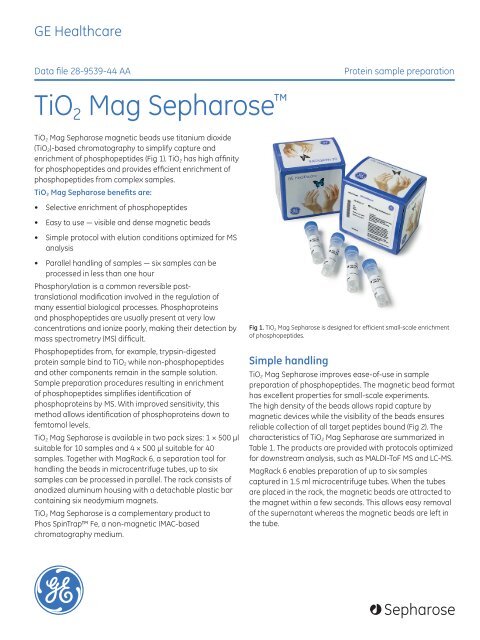
![[PDF] マニュアル GradiFrac](https://img.yumpu.com/22037825/1/190x253/pdf-gradifrac.jpg?quality=85)
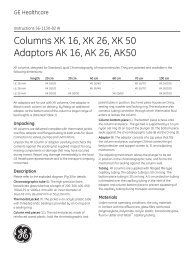
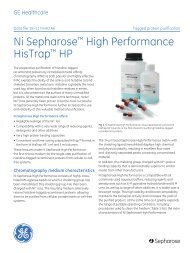
![[PDF] Sample preparation for analysis of protein, peptides and ...](https://img.yumpu.com/21549715/1/190x257/pdf-sample-preparation-for-analysis-of-protein-peptides-and-.jpg?quality=85)
![[PDF] Data File: rProtein A Sepharose Fast Flow](https://img.yumpu.com/21549316/1/190x253/pdf-data-file-rprotein-a-sepharose-fast-flow.jpg?quality=85)
![[PDF] MBP-tagged protein purification](https://img.yumpu.com/21548507/1/184x260/pdf-mbp-tagged-protein-purification.jpg?quality=85)
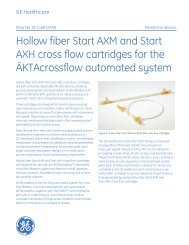
![[PDF] AKTA ready system Data file](https://img.yumpu.com/21540925/1/190x253/pdf-akta-ready-system-data-file.jpg?quality=85)
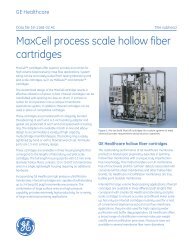
![[PDF] Data File - rProtein A/Protein G GraviTrap](https://img.yumpu.com/21539052/1/190x253/pdf-data-file-rprotein-a-protein-g-gravitrap.jpg?quality=85)
